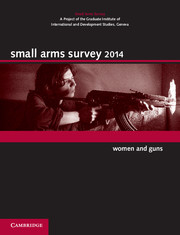Book contents
- Frontmatter
- Foreword
- Contents
- About the Small Arms Survey
- Notes to readers
- Acknowledgements
- Introduction
- Chapter 1 In War and Peace: Violence against Women and Girls
- Chapter 2 Converging Agendas: Women, Peace, Security, and Small Arms
- Special Feature. Women behind the Gun: Aiming for Equality and Recognition
- Chapter 3 Breaking New Ground?: The Arms Trade Treaty
- Chapter 4 Trade Update: Transfers, Retransfers, and the ATT
- Chapter 5 Countdown to Catastrophe: The Mpila Ammunition Depot Explosions
- Chapter 6 Across Conflict zones: Ammunition Profiling
- Chapter 7 Signs of Supply: Weapons Tracing in Sudan and South Sudan
- Chapter 8 On the Record: Illicit Weapons in the the United States
- Index
Chapter 8 - On the Record: Illicit Weapons in the the United States
Published online by Cambridge University Press: 05 July 2014
- Frontmatter
- Foreword
- Contents
- About the Small Arms Survey
- Notes to readers
- Acknowledgements
- Introduction
- Chapter 1 In War and Peace: Violence against Women and Girls
- Chapter 2 Converging Agendas: Women, Peace, Security, and Small Arms
- Special Feature. Women behind the Gun: Aiming for Equality and Recognition
- Chapter 3 Breaking New Ground?: The Arms Trade Treaty
- Chapter 4 Trade Update: Transfers, Retransfers, and the ATT
- Chapter 5 Countdown to Catastrophe: The Mpila Ammunition Depot Explosions
- Chapter 6 Across Conflict zones: Ammunition Profiling
- Chapter 7 Signs of Supply: Weapons Tracing in Sudan and South Sudan
- Chapter 8 On the Record: Illicit Weapons in the the United States
- Index
Summary
INTRODUCTION
During the crack epidemic in the United States in the 1980s and early 1990s, a steady stream of movies, television shows, and songs depicting gang life and drug violence in US cities captured the popular imagination. Among the most startling of these images were drive-by shootings: teenaged gang members spraying blighted city neighbourhoods with bullets fired from automatic rifles and machine pistols. These scenes—and the assumptions that underpin them—continue to shape public perceptions of urban violence in the United States today. But how accurate are these images? Are automatic rifles and machine pistols as widely used by drug traffickers and gang members as commonly assumed? If not, what weapons do they rely on, and are they the same as the weapons acquired by other criminals? Do the types of weapons seized from criminals vary from city to city?
This chapter seeks to answer these questions through an analysis of data on firearms and other weapons recovered by US law enforcement authorities. It is the third instalment of the Small Arms Survey's multi-year study on illicit small arms and light weapons, which seeks to improve public understanding of illicit weapons by obtaining and analysing previously unreleased or under-utilized data from official (government) sources. To this end, the Survey obtained records on more than 140,000 small arms, light weapons, and rounds of light weapons ammunition taken into custody by police in eight US cities and towns. The records shed light on weapons seized from felons, drug traffickers, gang members, and other violent criminals.
- Type
- Chapter
- Information
- Small Arms Survey 2014Women and Guns, pp. 244 - 273Publisher: Cambridge University PressPrint publication year: 2014



